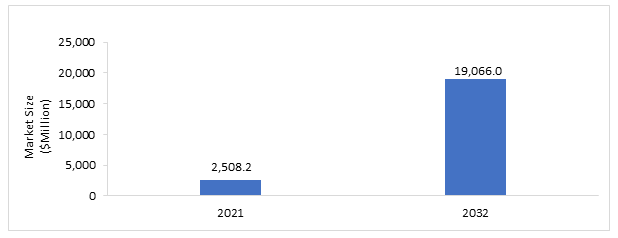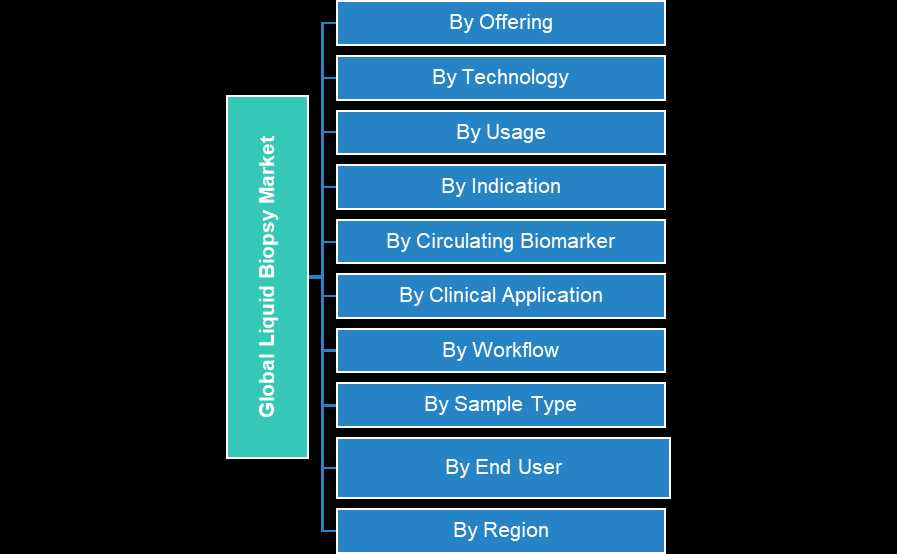Liquid biopsy is an essential part of medical decision-making and aids in obtaining information for a wide range of treatment dissemination. Liquid biopsy has a crucial role in the precision medicine approach, as it confirms the safe and effective application of targeted therapeutics.
The global liquid biopsy market was estimated to be at $2,508.2 million in 2021, which is expected to grow with a CAGR of 19.83% and reach $19,066.0 million by 2032. The growth in the global liquid biopsy market is expected to be driven by increasing adoption of NGS in various research fields, advancement in NGS, and increase in the adoption of personalized medicine.

Liquid biopsy can be used as a better alternative for treatment and recurrence monitoring as it overcomes invasive biopsy challenges of taking a tumor sample again and again during the course of the treatment. Next-generation sequencing (NGS) is a DNA sequencing technology that has transformed genomic research. It is considered a high-throughput technology that helps rapid sequencing of the base pairs in DNA or RNA samples. Next-generation sequencing helps a broad range of applications, for instance, gene expression profiling, chromosome counting, detection of epigenetic changes, and molecular analysis. Next-generation sequencing enables drug discovery and empowers the potential in personalized medicine.
Impact
• Rising global prevalence of cancers and the growing need for early detection coupled with efficient treatment monitoring and recurrence detection is anticipated to support the growth of the global liquid biopsy market during the forecast period 2022-2032.
• The market is expected to grow at a significant growth rate due to opportunities such as the introduction of informatics and technological innovations for a large customer base and increasing adoption of cancer and other disease testing services.
Impact of COVID-19
The current global liquid biopsy market comprises various indications such as lung cancer, breast cancer, prostate cancer, and many others. It has been noticed that there has been a reduction in the capacity or shutdowns of laboratories and other research institutions, which have led to reduced usage of various products and services related to research.
The government imposed various restrictions during COVID-19, such as travel bans, quarantines, curfews, business shutdowns, and closures. This led to an increased cost of the COVID-19-related services. There have been many issues during the COVID-19 pandemic, such as operational failures, shipping issues, inaccurate demand forecasts, and other production issues.
Furthermore, the health and the safety of employees were impacted as COVID-19 reduced the efficacy of employees' work potential. However, the market related to COVID-19 grew during the pandemic as customers were in need of testing services. Overall, the impact of COVID-19 on the market size has been low-moderate. Some market players have reported a slight decline in sales. However, financials are already on their way to recovery. The decline in revenues was mostly a result of the initial phases of the COVID-19 pandemic, which comprised complete lockdowns across countries and major cities, thus interrupting the supply chain. The timeline of impact spanned the end of the first quarter and the second quarter of 2020 for most key markets across the globe. However, the pandemic has played a key role in enhancing the growth prospects of liquid biopsy and is expected to indirectly aid in improving the market growth outlook.
Global Liquid Biopsy Market Segmentation

Recent Developments in the Global Liquid Biopsy Market
• Product Launch in 2020: Sysmex Corporation launched liquid biopsy RUO kits in EMEA region. The kits name is Plasma-SeqSensei, and it is used for non-small cell lung cancer (NSCLC), melanoma, and thyroid cancer.
• Partnership: In 2021, Illumina, Inc. collaborated with Bristol Myers Squibb to innovate and enhance companion diagnostics for therapy selection to further precision oncology. TSO 500 ctDNA is one of the first liquid biopsy assays to enable comprehensive genomic profiling for therapy selection.
• Collaboration: In 2021, QIAGEN collaborated with Sysmex Corporation for the development and commercialization of cancer companion diagnostics using NGS and Plasma-Safe-SeqS technology.
Global Liquid Biopsy Market Dynamics

Key Questions Answered in the Report
- What are the major market drivers, challenges, and opportunities in the global liquid biopsy market?
- What are the key development strategies which are implemented by the major players to sustain in the competitive market?
- Which is the dominant product type developed by the leading and emerging players for liquid biopsy?
- What are the key technologies that have been used by leading players in the global liquid biopsy market to develop diagnostic and research solutions for cancer?
- How is each segment of the market expected to grow during the forecast period from 2022 to 2032? Following are the segments:
- Offering (testing service, kits, other consumables, and platform)
- Technology (next-generation sequencing (NGS), polymerase chain reaction (PCR), other technologies, and emerging technologies)
- Usage (research and clinical)
- Circulating Biomarker (circulating tumor cells, cell-free DNA, circulating cell-free RNAs, exosomes and extracellular vesicles and others, and other circulating biomarkers)
- Workflow (sample preparation, library preparation, sequencing, and data analysis and management)
- Sample (blood, urine, saliva and others)
- Indication (lung cancer, breast cancer, prostate cancer, colorectal cancer, melanoma, other types of cancer, and non-oncology disorder)
- Clinical Application (treatment monitoring, prognosis and recurrence monitoring, treatment selection and diagnosis and screening)
- End User (academic and research institutions, clinical laboratories, pharmaceutical and biotechnology companies, and other end users)
- Region (North America, Europe, Asia-Pacific, Latin America and Middle East, and Rest-of-the-World)
- Which companies are anticipated to be highly disruptive in the future, and why?
- What are the reimbursement scenario and the regulations for liquid biopsies globally?
- Considering next-generation sequencing (NGS), what is the most important factor among price, sensitivity, and turnaround time, to increase the adoption of NGS-based liquid biopsy in the near future?
- From the end-users' point of view, does efficiency or convenience hold the key to driving the global liquid biopsy market?
- What are your treatment guidelines for the different types of cancer?
- What is the average number of liquid biopsies being conducted on each patient throughout the duration of their stay?
Get Free Sample Report - https://bisresearch.com/requestsample?id=1303type=download
Analyst Thoughts
According to Nitish Kumar, Principal Analyst, BIS Research, "North America is the leading contributor in the global liquid biopsy market. It contributed approximately 54.17% to the North American market value in 2021. This region is anticipated to grow at a CAGR of 19.22% during the forecast period 2022-2032 and will continue dominating the market in 2032.”
BIS Related Studies
NGS Sample Preparation Market - A Global and Regional Analysis
Comments
Post a Comment